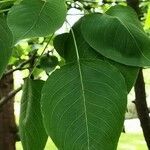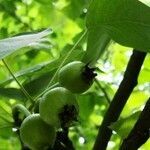Trees to 7–15 m tall. Branchlets purplish brown or dark brown when old, terete, tawny villous or tawny tomentose when young, soon glabrescent, glabrous when old, sparsely lenticellate; buds narrowly ovoid, apex obtuse; scales tomentose at margin and apex. Stipules caducous, linear-lanceolate, 1–1.5 cm, membranous, margin villous and entire, apex acuminate; petiole 3–4.5 cm, initially tomentose, glabrescent; leaf blade ovate-elliptic or ovate, 7–12 × 4–6.5 cm, glabrous or brown lanate when young, base rounded or subcordate, rarely broadly cuneate, margin spinulose-serrate, apex acute. Raceme umbel-like, 6–9-flowered; peduncle sparsely pubescent when young; bracts caducous, linear, 1–1.4 cm, membranous, villous at margin, apex acuminate. Pedicel 3.5–5 cm; sparsely pubescent when young. Flowers 2.5–3.5 cm in diam. Hypanthium cupular, abaxially glabrous. Sepals triangular-ovate, ca. 5 mm, abaxially glabrous, adaxially brown tomentose, margin glandular denticulate, apex acuminate. Petals white, ovate, 1.5–1.7 cm, base shortly clawed, apex rounded. Stamens 20, ca. 1/2 as long as petals. Ovary 5-or 4-loculed, with 2 ovules per locule; styles 5, rarely 4, nearly as long as stamens, glabrous. Pome brownish, with pale dots, subglobose, 2–2.5 cm in diam., (4-or)5-loculed; sepals caducous; fruiting pedicel 3.5–5.5 cm, subglabrous. Fl. Apr, fr. Aug. 2n = 34*, 51*.
More
Plants 70–150 dm. Branches purplish brown or dark brown, tawny villous or tomentose when young, glabrescent; thorns usually absent. Leaves: petiole 3–4.5 cm, tomentose when young; blade ovate or ovate-elliptic, 7–12 × 4–6.5 cm, base rounded or subcordate, margins spinulose-serrate, apex acute, surfaces glabrous or brown-lanate when young. Pedicels 3.5–5 cm, pubescent when young. Flowers 25–35 mm diam.; sepals triangular-ovate, 5 mm, apex acuminate; petals white, ovate, 15–17 mm; ovaries 5-locular; styles 5. Pomes brownish with pale dots, subglobose, 20–25 mm diam.; sepals deciduous. 2n = 34.
A medium sized tree. It grows 15 m high and spreads 9 m wide. The leaves are oblong and have teeth along the edge. The leaves turn orange and bronze in the autumn. The flowers are small and white. They appear almost the same time as the leaves. The fruit is round and the size of an apple. The skin is thin. They can be green, yellow or bronze. They have a gritty texture. Some forms have larger, softer fruit. These cultivated forms may be crosses between Pyrus pyrifolia and Pyrus ussuriensis. These are oval and yellow with a crisp texture.
Differing in its more sharply serrate lvs, slightly larger fls, and subglobose fr, seldom escapes in our range.
It is a temperate plant. In Vietnam it is cultivated in the northern highlands between 1,000 and 1,500 m altitude. It needs 300-800 hours of cold below 7°C each year. They are hardy to frost. They will grow on most soils. In Hobart Botanical gardens. In XTBG Yunnan. It suits hardiness zones 4-9. In Sichuan and Yunnan. Arboretum Tasmania.
More
Warm rainy regions; at elevations from 100-1,400 metres. Naturalized in low mountains and around villages in C. And S. Japan.


